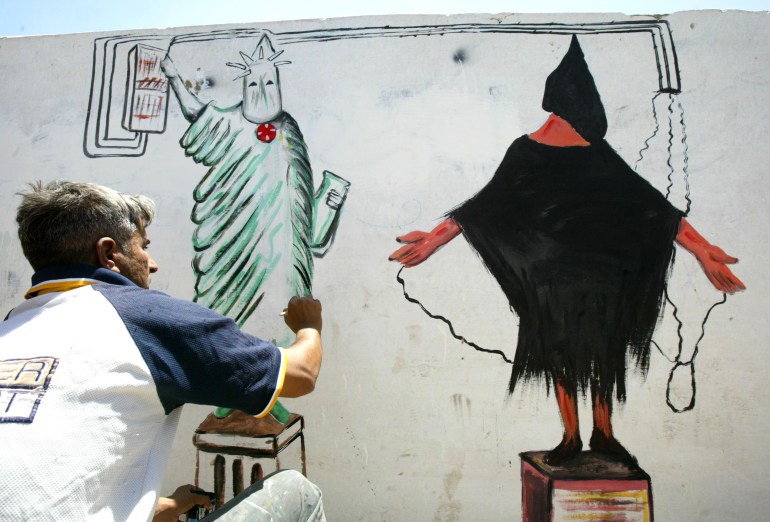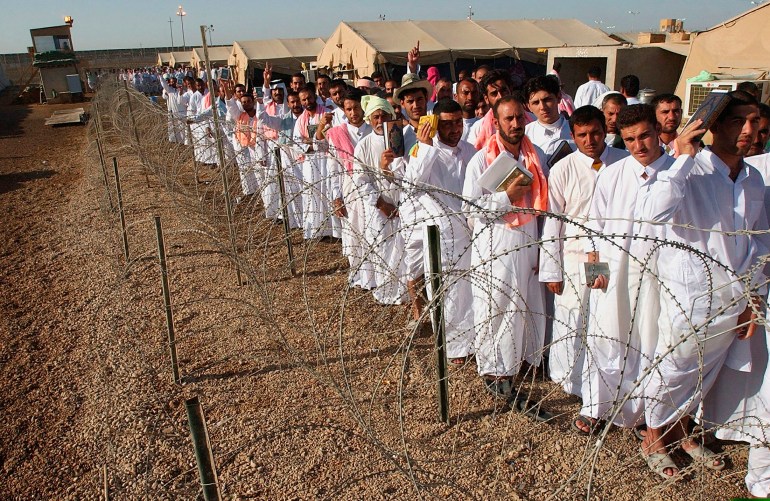When the US television news program 60 Minutes II published images of Iraqi men being abused and humiliated by their American prison guards at Abu Ghraib prison in Iraq 20 years ago this weekend, the United States-led invasion and subsequent occupation of Iraq was just underway once 13 months ago.
Deposed Iraqi President Saddam Hussein, captured by U.S. forces more than four months earlier, was awaiting trial on charges of crimes against humanity, and the Iraqi state itself was reeling from violence and unrest.
For many in the Arab world, Abu Ghraib quickly became a symbol of US imperialism and hypocrisy, refuting then-US President George W. Bush’s repeated claims that the US was a bastion of human rights.
Two decades later, a civil case brought by Abu Ghraib victims against a U.S. contractor who worked at the prison is pending. Many are now viewing Israel’s ongoing U.S.-backed military action in the Gaza Strip, where more than 34,000 Palestinians have been killed since October, through the prism of the Abu Ghraib scandal, which first came to light on April 28, 2004 and sent shock waves throughout World.
What did the pictures from Abu Ghraib show?
Photos aired on 60 Minutes showed U.S. guards at Abu Ghraib subjecting Iraqi prisoners to various forms of violence, sexual assault and humiliation. Many of the prisoners had been arrested by U.S. soldiers on suspicion of belonging to armed groups, but according to the International Red Cross, 70 to 90 percent of them were innocent bystanders who had been mistakenly arrested.
One image showed naked prisoners stacked together in a pyramid while their U.S. captors stood smiling behind them. Another showed a US soldier holding a naked prisoner on a leash.
The defining image of the scandal, however, was the haunting depiction of a hooded Iraqi man holding electrical wires and standing on a box.
Then-U.S. Gen. Mark Kimmitt, who was deputy director of coalition operations in Iraq and was interviewed for the April 2004 CBS News story, said: “Frankly, I think we are all disappointed by the actions of a few. You know, every day we love our soldiers… but honestly, some days we’re not always proud of our soldiers.”
Subsequent revelations by CBS News revealed that the U.S. Army report on which the U.S. network based its original Abu Ghraib story actually contained “numerous incidents of sadistic, blatant and wanton criminal abuse” of Iraqis by U.S. soldiers in prison described in detail.

Was there further evidence of abuses at Abu Ghraib?
Shortly after the photos of U.S. soldiers humiliating and abusing Iraqi men were published on CBS News, the International Committee of the Red Cross released its own report on prison abuses.
The report detailed ill-treatment observed by Red Cross observers between March and November 2003 and committed “during arrest, internment and interrogation,” particularly of “individuals arrested in connection with suspected security crimes or who were subject to an ‘intelligence’ value is attributed”.
The Red Cross said it had uncovered numerous examples of violations of the Geneva Conventions by U.S. military personnel. For example, the report said Red Cross monitors observed U.S. soldiers abusing Abu Ghraib prisoners by keeping them naked in empty cells in complete darkness.
In the summary of its report, the Red Cross said so-called high-value prisoners “are at high risk of being subjected to a variety of harsh treatments, ranging from insults, threats and humiliation to physical and psychological coercion, which in “In some cases it also leads to physical and psychological coercion.” amounted to torture in order to force cooperation with their interrogators.”
The abuse amounted to “in some cases torture,” the Red Cross report said.
Have US soldiers been held accountable?
Private Lynndie England, the soldier pictured holding a leash on a naked Iraqi man lying on the floor at Abu Ghraib prison, which had itself been a notorious place of torture during Saddam Hussein’s presidency, appeared in several prisoner abuse images. In 2005, England was found guilty of six counts of abuse by a US military tribunal and sentenced to three years in prison. She was released in March 2007.
Charles Graner Jr., a U.S. Army prison guard convicted by a military court of masterminding the abuse of detainees at Abu Ghraib, was sentenced to 10 years in prison in 2005 after being convicted of five counts of assault, abuse and conspiracy was. Graner was released in August 2011.
Of the 11 soldiers court-martialed by the U.S. military for mistreating Iraqi prisoners at Abu Ghraib, nine were sentenced to prison.
However, it soon became clear that the US’s mistreatment of Iraqi detainees was not limited to Abu Ghraib. Indeed, after CBS uncovered the Abu Ghraib scandal, the news organization learned of the existence of interviews with Army investigators who also revealed mistreatment of prisoners at other detention centers in Iraq, such as Al-Mahmudiya Prison, a temporary detention facility , for which other US military personnel were also imprisoned.

Have Iraqi victims of US torture received any kind of reparations?
In September, Human Rights Watch said: “The US government appears to have failed to provide compensation or compensation to Iraqis who suffered torture and other ill-treatment at the hands of US forces at Abu Ghraib and other US-run prisons in Iraq two decades ago to grant other redress.”
The existence of the Federal Tort Claims Act, which gives the U.S. government immunity from all lawsuits arising during wartime, makes it particularly difficult to seek redress.
Instead, Iraqi victims of U.S. abuses were forced to prosecute U.S. military contractors who, according to Chris Bartlett, a U.S. photographer who has been photographing portraits of Abu Ghraib torture survivors since 2006, told Al Jazeera, “hired to create a layer of liability “. Distance so that the federal government can be shielded from responsibility.”
Most recently, on April 15 of this year, a federal court in Virginia began hearing the case Al Shimari et al. against CACI, a private security firm hired by the U.S. government to interrogate Iraqi prisoners at Abu Ghraib in 2003.
The defendants are represented by the U.S.-based Center for Constitutional Rights, which secured a $5 million settlement for its Iraqi clients in 2013 from Titan Corp, another military contractor operating at Abu Ghraib.
In the Virginia case, the advocacy group is seeking compensation for three Iraqi clients – Suhail Najim Abdullah Al Shimari, Salah Al-Ejaili and As’ad Al-Zuba’e – who allege that “CACI engaged in a conspiracy to commit unlawful conduct , including …”torture and war crimes in Abu Ghraib prison,” where they were tortured.
On Monday, the eight-member jury in the case retired to consider its verdict.
Why was Israel’s war on Gaza compared to US torture at Abu Ghraib?
Israel’s deadly airstrike campaign against the Hamas-ruled Gaza Strip, which began on October 7, was soon followed by reports of Israeli soldiers beating and humiliating detained Palestinians, which many compared to US torture at Abu Ghraib.
On October 31, pro-Palestinian advocacy group Jewish Voice for Peace wrote on X: “The footage of Israeli soldiers torturing Palestinian men in the West Bank is horrific.” The Israeli military has brutalized Palestinian prisoners for decades. As the Israeli military wages a genocidal war in Gaza, its soldiers are no longer hiding these abuses from the public.”
It added: “It is no surprise … that the same government that tortured Iraqis at Abu Ghraib is funding the same tactics against Palestinians.”
Sarah Sanbar, an Iraq researcher at Human Rights Watch, told Al Jazeera that a former Iraqi detainee told her that images of stripped Palestinians being rounded up and held by Israeli forces in Gaza were “very retraumatizing and triggering and had him.” “taken right back to 2003 and 2004.” when he was tortured [by the Americans] in Abu Ghraib.”
